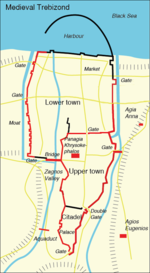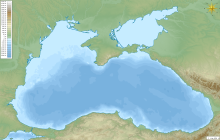
Back فتح طرابزون (1461) Arabic Setge de Trebisonda (1461) Catalan Pád Trapezuntu Czech Πολιορκία της Τραπεζούντας (1461) Greek Caída de Trebisonda Spanish محاصره ترابوزان (۱۴۶۱) Persian Siège de Trébizonde (1461) French Caduta di Trebisonda Italian トレビゾンド包囲戦 (1461年) Japanese ტრაპიზონის ალყა (1461) Georgian
| Siege of Trebizond | |||||||
|---|---|---|---|---|---|---|---|
| Part of the Byzantine–Ottoman Wars | |||||||
 Fortification plan of (central) medieval Trebizond (modern Trabzon, Turkey). Current remains in red. | |||||||
| |||||||
| Belligerents | |||||||
|
|
| ||||||
| Commanders and leaders | |||||||
|
|
| ||||||
| Strength | |||||||
|
80,000 infantry 200 galleys[2] | Unknown | ||||||
Location within Turkey | |||||||
The siege of Trebizond was the successful siege of the city of Trebizond, capital of the Empire of Trebizond, by the Ottomans under Sultan Mehmed II, which ended on 15 August 1461.[1] The siege culminated a lengthy campaign on the Ottoman side, which involved coordinated but independent manoeuvres by a large army and navy. The Trapezuntine defenders had relied on a network of alliances, which would provide them with support and a workforce when the Ottomans began their siege. Still, it failed when Emperor David Megas Komnenos most needed it.
The Ottoman land campaign, which was the more challenging part, involved intimidating the ruler of Sinope into surrendering his realm, a march lasting more than a month through uninhabited mountainous wilderness, several minor battles with different opponents and finally the siege of Trebizond. The combined Ottoman forces blockaded the fortified city by land and sea until Emperor David agreed to surrender his capital city on terms. In return for his tiny realm, he would be given properties elsewhere in the Ottoman Empire, where he, his family, and his courtiers would live until their execution some two years later. For the rest of the inhabitants of Trebizond, The Sultan divided them into three groups. One group was forced to leave Trebizond and resettle in Constantinople. Another group became slaves either of the Sultan or of his dignitaries. The last group was left to live in the countryside surrounding Trebizond but not within its walls. Some 800 male children became recruits for his Janissaries, the elite Ottoman military unit, which required them to convert to Islam.[3]
With the last members of the Palaiologan dynasty having fled the Despotate of the Morea the previous year for Italy, Trebizond had become the last outpost of Byzantine civilization, which came to an end with Trebizond's fall.[4] "It was the end of the free Greek world," wrote Steven Runciman, who then noted that those Greeks still not under Ottoman rule lived "under lords of an alien race and an alien form of Christianity. Only among the wild villages of Mani, in the southeastern Peloponnese, into whose rugged mountains no Turk ventured to penetrate, was there left any semblance of liberty."[5][better source needed]
- ^ a b This is the date determined by Franz Babinger, "La date de la prise de Trébizonde par les Turcs (1461)", Revue des études byzantines, 7 (1949), pp. 205–207 doi:10.3406/rebyz.1949.1014
- ^ John Freely, The Grand Turk: Sultan Mehmed II, Conqueror of Constantinople and Master of an Empire (New York: Overlook Press, 2009), p. 67
- ^ William Miller, Trebizond: The last Greek Empire of the Byzantine Era: 1204–1461, 1926 (Chicago: Argonaut, 1969), p. 106
- ^ As pointed out by Donald M. Nicol, The Last Centuries of Byzantium, 1261–1453, second edition (Cambridge: University Press, 1993), with Trebizond died the last vestiges of the Roman Empire p. 401
- ^ Runciman, The Fall of Constantinople: 1453 (Cambridge: University Press, 1969), p. 176

